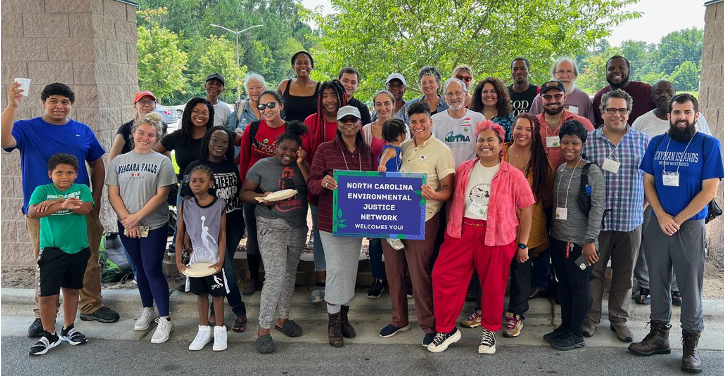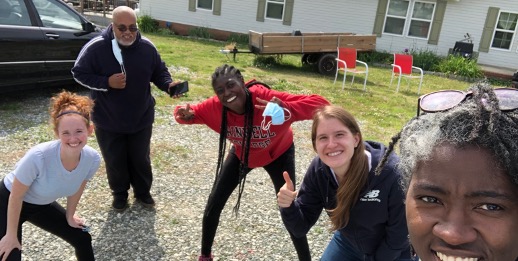Current Activities
1. Private Well Water Quality in Sampson Co. with EJCAN
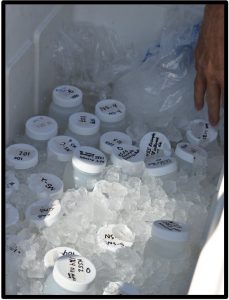
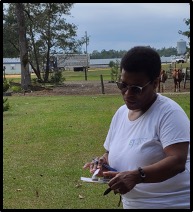
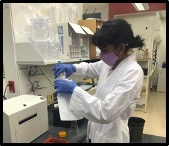 Issue:
Issue:
NC has the highest number of private well users in the US, and private wells are not regulated by federal or state drinking water standards. With the high level of agricultural waste, solid waste management and other industrial activities in Sampson County, private drinking wells may be at risk of becoming contaminated.
Goal:
1) Determine extent and type of water contamination across the county, 2) Provide residents with data on their water quality, and 3) understand their perceptions of contaminant exposure risk
Activities:
- Measure heavy metals, nutrients, PFAS and fecal bacteria
- Survey residents to understand risk perception, well depth and water source preference
- Conducted ~150 tests
Photo credits: Rebecca Witter
Project work supported by and in partnership with:
2. Water Quality and Infrastructure Access in Sampson County
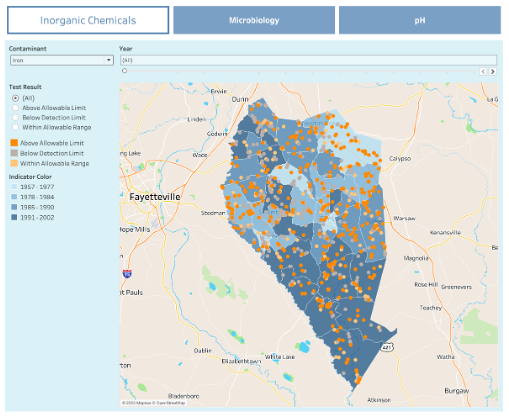 Issue:
Issue:
Inequitable water access and quality for private well users in Sampson County
Goal:
Understand what is needed to provide sustainable support/infrastructure to residents for safe drinking water in Sampson county
Activities:
- Develop a web tool to help residents identify nearby water threats and decisions makers to identify “high-impact” communities for water-related investment
- Gauge one’s physical access to public water infrastructure and proximity to factors that may influence exposure risk
- Enable users to identify trends in the relationship between contaminant rates and demographic indicators
- Engage a range of interested parties to understand the barriers and promoters of safe drinking water access
- Identified themes from 1-on-1 semi-structured interviews with 23 participants from 6 different groups (research institutions, government, utilities, technical well experts, residents, non-profits) using a Rapid Qualitative Data Analysis approach (Hamilton, 2021)
“Let’s all try to turn around this problem — that we’re dealing with the demise of the quality of life in our, in our rural county.”
– Resident
Project work supported by and in partnership with:




3. Landscape Analysis of EJ Work in NC
Issue:
Many organizations now have a desire to engage with environmental justice (EJ) communities and/engage in EJ work; however, it is unclear whether organizations share similar understandings of what EJ work entails, and strategic communication and collaboration across these organizations could strengthen the EJ movement in NC.
Goal:
Identify 1) what current environmental justice issues are being addressed, 2) what populations are being served and in which regions of the state, 3) what primary strategies are organizers/ organizations using to facilitate change and 4) what resources do they have and/or need to continue their work
Activities:
- Identified traditional and grassroots environmental groups in NC,
- Conducted a survey of over 20 organizations
- Interviewed representatives from a select of survey respondents.
Project work supported by and in partnership with:



4. Applying an EJ Lens to Farmworker Health Issues
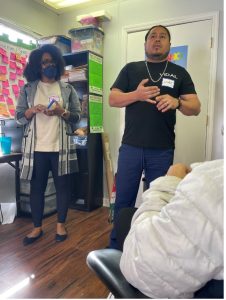 Issue:
Issue:
Farmworkers face dangerous work and environmental conditions with limited regulations & protections
Goal:
Support NC FIELD in addressing pressing farmworker health issues; Generate a Theory of Change model to inform NC FIELD’s actions over the next 5-10 years
Activities:
- Working with NC FIELD to develop a strategic plan
- Supporting data organization and analysis
- Providing technical and research support on EJ-related grants focused on heat stress in farmworkers
Project work supported by and in partnership with:








5. Farmworker Oral Histories & Community Health Survey
Issue:
Given the geographic and social isolation of rural migrant farmworkers, few accounts exist in NC of farmworker’s lived experiences, expressed in their voice. Furthermore, advocacy organizations that support farmworker issues can better document their experiences supporting farmworker communities.
Goal:
Gather narratives from farmworkers and advocacy org staff to document their experiences, particularly as it relates to access to health-related resources and health conditions that farmworkers face.
Activities:
- Collecting oral histories from farmworkers and NC FIELD team members to understand and formally document the history of NC FIELD as an organization and the paths of NC FIELD staff members that led them to their current roles
- Conducting community health survey on health-related issues experienced by farmworkers
Project work supported by and in partnership with:



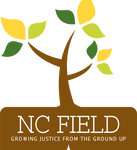
6. Health & Environmental Impacts of Wood Pellet Facilities
Issue:
Wood Pellet manufacturing plants have expanded across the southeastern United States since the early 2010s and their impact on the communities in which they operate has largely been documented through activism and resident testimonials. Greater research is needed to address the impact of wood pellet mills on communities in the southeastern United States and to advocate for environmental justice.
Goal:
Develop and implement a community survey on the health and quality of life impacts of wood pellet mills on households located near four specific wood pellet mills in North Carolina. After initial implementation, SELC hopes to expand the use of the survey to community leaders in Mississippi and Alabama as well.
Activities:
- Compile an initial draft of qualitative and quantitative survey questions from previous surveys produced by the EJ Clinic for the SELC and Impacted Communities Against Wood Pellet Mills
- Attend work group meetings to adapt the survey to the communities being served and to the scope of work
- Serve as consultants on questions of research feasibility, scope of work, implementation strategies and analysis brainstorming
Project work supported by and in partnership with:



7. Assessing Cumulative Impacts
 Issue:
Issue:
Many communities experience environmental racism, which can lead to disproportionate pollution exposure. Environmental and social stressors can act in combination to cause new or exacerbate existing health issues (known as cumulative impacts)
Goal:
Make recommendations to EJ and Equity Advisory Board to inform NC Dept. of Envr. Quality’s permitting policies related to cumulative impacts to prevent additional harms to overburdened communities
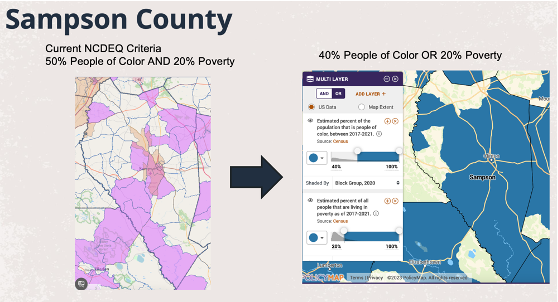 Activities:
Activities:
- Reviewed more than 45 cumulative impact definitions across federal and state agencies and identified themes across the definitions
- Assessed 41 hazard mapping tools
- Identified what indicators are used across tools and which indicators are the most used
- Compared how tools consider different population thresholds and how/if they identify Cumulative Impacts or EJ areas
Project work supported by and in partnership with:


8. Spidey Sens-R Air Quality Monitoring with NCEJN
Issue:
There are few participatory methods that allow for inexpensive analysis of metals in air pollution at a high spatial resolution.
Goal:
Support citizen science research to assess changes in air pollution levels near coal ash reburning facilities.
Activities:
- Help collect spider webs
- Extract dust from webs and analyze for the quantity of metals
- Support report-back meetings with communities to share findings and identify next steps
Photo Credits: Sanzari Aranyak, NCEJN (2023)
Project work supported by and in partnership with:



9. Participatory Data Collection and Report Back for Emerging Contaminants
Issue:
PFAS or “forever chemicals” are linked to a variety of negative, long-term health issues. PFAS are released into the environment via landfills, manufacturing facilities, and wastewater treatment plants and can threaten groundwater quality and private wells.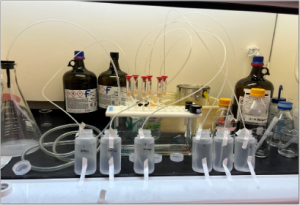
Goal:
Enhance community knowledge about PFAS exposure and engage community advocates and youth in PFAS education and awareness.
Activities:
- Identified key landfills and identifying community partners
- Report-back material development in progress
- Hosting an infographic competition to engage rural youth in PFAS education
- Sampling private well water this fall using a participatory door-hanger approach
Project work supported by and in partnership with:


10. Anderson Community Health & Environmental Quality Assessment
 Issue:
Issue:
The Anderson Community, a predominantly Black community with a high prevalence of chronic health issues and disability in Caswell County, has been selected as the proposed site for an asphalt plant
Goal:
Support the Anderson Community Group’s advocacy efforts against the proposed facility
Activities:
- Survey to assess self-reported health status & environmental quality in the Anderson Community
- Facilitate education on environmental health risks and encourage civic participation
- Support grant applications
- Next Steps: Water quality monitoring project
Project work supported by and in partnership with:








